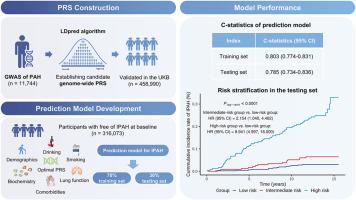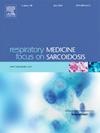多基因风险评分和临床因素预测特发性肺动脉高压的发生。
IF 3.1
3区 医学
Q2 CARDIAC & CARDIOVASCULAR SYSTEMS
引用次数: 0
摘要
背景:本研究旨在建立一种综合多基因风险评分(PRS)和临床因素的综合预测模型,以识别特发性肺动脉高压(IPAH)的高危人群。方法:利用汇总统计数据构建PRS,该数据来源于欧洲最大的肺动脉高压全基因组关联研究,并在英国生物银行(732例,458,258例对照)中得到验证。在基线时排除IPAH患者后,316,073名参与者(316例IPAH患者)被分为训练组和测试组(7:3)。采用最小绝对收缩法和训练集选择算子进行变量选择,采用Cox比例风险模型建立IPAH事件预测模型。结果:在多基因风险层中,IPAH风险估计值呈梯度增加(趋势P = 0.0035)。与低PRS个体相比,高PRS个体的风险显著增加38.5% (OR: 1.385, 95% CI: 1.105, 1.736)。选择18个预测因子纳入综合预测模型,训练集和测试集的c统计量分别为0.803 (95% CI: 0.774, 0.831)和0.785 (95% CI: 0.734, 0.836)。使用预测模型进行风险分层后,高危组发生IPAH的风险是低危组的8.941倍。此外,18个独立因素中的14个进一步确定了IPAH的发生。结论:综合预测模型能有效识别IPAH高危人群,便于早期发现和个性化干预,降低疾病风险。本文章由计算机程序翻译,如有差异,请以英文原文为准。

Polygenic risk score and clinical factors predict incident idiopathic pulmonary arterial hypertension
Background
This study aimed to develop a comprehensive prediction model integrating polygenic risk scores (PRS) and clinical factors to identify individuals at high risk for incident idiopathic pulmonary arterial hypertension (IPAH).
Methods
A PRS was constructed using summary statistics derived from the largest genome-wide association study for pulmonary arterial hypertension in Europeans and validated in the UK Biobank (732 cases, 458,258 controls). After excluding individuals with IPAH at baseline, 316,073 participants (316 incident IPAH patients) were split into training and testing sets (7:3). Variable selection was performed using least absolute shrinkage and selection operator in the training set, and a prediction model for incident IPAH was established using the Cox proportional hazards model.
Results
A gradient increase in IPAH risk estimates was observed across polygenic risk strata (P for trend = 0.0035). Compared with individuals with low PRS, those with high PRS had a significant 38.5 % increased risk (OR: 1.385, 95 % CI: 1.105, 1.736). Eighteen predictors were selected and included in the comprehensive prediction model, achieving C-statistics of 0.803 (95 % CI: 0.774, 0.831) and 0.785 (95 % CI: 0.734, 0.836) in the training and testing sets, respectively. Following risk stratification using the prediction model, the high‐risk group exhibited an 8.941‐fold higher risk of incident IPAH compared to the low‐risk group. Moreover, 14 of 18 independent factors of incident IPAH were further identified.
Conclusion
The integrated prediction model effectively identifies individuals at high risk for IPAH, facilitating early detection and personalized interventions to reduce disease risk.
求助全文
通过发布文献求助,成功后即可免费获取论文全文。
去求助
来源期刊

Respiratory medicine
医学-呼吸系统
CiteScore
7.50
自引率
0.00%
发文量
199
审稿时长
38 days
期刊介绍:
Respiratory Medicine is an internationally-renowned journal devoted to the rapid publication of clinically-relevant respiratory medicine research. It combines cutting-edge original research with state-of-the-art reviews dealing with all aspects of respiratory diseases and therapeutic interventions. Topics include adult and paediatric medicine, epidemiology, immunology and cell biology, physiology, occupational disorders, and the role of allergens and pollutants.
Respiratory Medicine is increasingly the journal of choice for publication of phased trial work, commenting on effectiveness, dosage and methods of action.
 求助内容:
求助内容: 应助结果提醒方式:
应助结果提醒方式:


